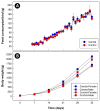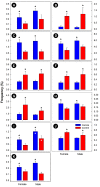Expeller-Pressed Canola (Brassica napus) Meal Modulates the Structure and Function of the Cecal Microbiota, and Alters the Metabolome of the Pancreas, Liver, and Breast Muscle of Broiler Chickens
- PMID: 33672178
- PMCID: PMC7926547
- DOI: 10.3390/ani11020577
Expeller-Pressed Canola (Brassica napus) Meal Modulates the Structure and Function of the Cecal Microbiota, and Alters the Metabolome of the Pancreas, Liver, and Breast Muscle of Broiler Chickens
Abstract
The inoculation of one-day-old broiler chicks with the cecal contents from a mature broiler breeder resulted in a highly diverse and uniform cecal bacterial community. CM did not affect feed consumption, weight gain, nor the richness, evenness, or diversity of the cecal bacterial community. However, the structure of the bacterial community was altered in birds fed the CM diet. Although the CM diet was formulated to contain equivalent metabolizable energy to the control diet, it contained more dietary fiber. The abundance of bacterial families, including those that are known to contain species able to metabolize fiber was altered (e.g., bacteria within the families, Methanobacteriaceae, Atopobiaceae, Prevotellaceae, Clostridiales Family XIII, Peptostreptococcaceae, and Succinivibrionaceae), and concentrations of SCFAs were higher in the ceca of birds fed the CM diet. Moreover, concentrations of isoleucine, isobutyrate, glutamate, and 2-oxoglutarate were higher, whereas concentrations of phenyllactic acid, indole, glucose, 3-phenylpropionate, and 2-oxobutyrate were lower in the digesta of chickens that were fed CM. The metabolic profiles of pancreas, liver, and breast muscle tissues of birds fed the CM diet differed from control birds. Metabolites that were associated with energy production, protection against oxidative stress, and pathways of amino acid and glycerophospholipid metabolism had altered concentrations in these tissues. Some of the observed changes in metabolite levels may indicate an increased disease risk in birds fed the CM diet (e.g., pancreatitis), and others suggested that birds mounted metabolic response to offset the adverse impacts of CM (e.g., oxidative stress in the liver).
Keywords: breast muscle; broiler chickens; canola meal; cecum; liver; metabolome; microbiota; pancreas.
Conflict of interest statement
The authors declare no conflict of interest.
Figures







Similar articles
-
Effect of elevated dietary amino acid levels in high canola meal diets on productive traits and cecal microbiota population of broiler chickens in a pair-feeding study.Poult Sci. 2017 May 1;96(5):1268-1279. doi: 10.3382/ps/pew388. Poult Sci. 2017. PMID: 27811325
-
Energy values of solvent-extracted canola meal and expeller-derived canola meal for broiler chickens and growing pigs determined using the regression method1.J Anim Sci. 2019 Jul 30;97(8):3415-3425. doi: 10.1093/jas/skz215. J Anim Sci. 2019. PMID: 31251813 Free PMC article.
-
Metabolizable energy and standardized ileal digestible amino acid contents of expeller-extracted canola meal fed to broiler chicks.Poult Sci. 2010 Jun;89(6):1182-9. doi: 10.3382/ps.2009-00595. Poult Sci. 2010. PMID: 20460665 Clinical Trial.
-
Impact of combined β-glucanase and xylanase enzymes on growth performance, nutrients utilization and gut microbiota in broiler chickens fed corn or wheat-based diets.Poult Sci. 2016 Mar;95(3):528-40. doi: 10.3382/ps/pev333. Epub 2015 Nov 14. Poult Sci. 2016. PMID: 26574039
-
Effects of expeller pressed camelina meal and/or canola meal on digestibility, performance and fatty acid composition of broiler chickens fed wheat-soybean meal-based diets.Arch Anim Nutr. 2012 Oct;66(5):402-15. doi: 10.1080/1745039X.2012.710082. Epub 2012 Aug 13. Arch Anim Nutr. 2012. PMID: 22881197 Clinical Trial.
Cited by
-
Dose-Responses Relationship in Glucose Lowering and Gut Dysbiosis to Saskatoon Berry Powder Supplementation in High Fat-High Sucrose Diet-Induced Insulin Resistant Mice.Microorganisms. 2021 Jul 21;9(8):1553. doi: 10.3390/microorganisms9081553. Microorganisms. 2021. PMID: 34442633 Free PMC article.
-
Infection by Salmonella enterica Serovar Typhimurium DT104 Modulates Immune Responses, the Metabolome, and the Function of the Enteric Microbiota in Neonatal Broiler Chickens.Pathogens. 2022 Oct 29;11(11):1257. doi: 10.3390/pathogens11111257. Pathogens. 2022. PMID: 36365008 Free PMC article.
-
Feather pulp: a novel substrate useful for proton nuclear magnetic resonance spectroscopy metabolomics and biomarker discovery.Poult Sci. 2022 Jul;101(7):101866. doi: 10.1016/j.psj.2022.101866. Epub 2022 Mar 23. Poult Sci. 2022. PMID: 35679673 Free PMC article.
-
A Potential Synbiotic Strategy for the Prevention of Type 2 Diabetes: Lactobacillus paracasei JY062 and Exopolysaccharide Isolated from Lactobacillus plantarum JY039.Nutrients. 2022 Jan 16;14(2):377. doi: 10.3390/nu14020377. Nutrients. 2022. PMID: 35057558 Free PMC article.
-
Microbiota Transplantation in Day-Old Broiler Chickens Ameliorates Necrotic Enteritis via Modulation of the Intestinal Microbiota and Host Immune Responses.Pathogens. 2022 Aug 26;11(9):972. doi: 10.3390/pathogens11090972. Pathogens. 2022. PMID: 36145404 Free PMC article.
References
-
- Government of Canada . Statistics Canada; 2020. [(accessed on 17 February 2021)]. Canola: A Canadian Success Story. Available online: https://www150.statcan.gc.ca/n1/pub/96-325-x/2007000/article/10778-eng.htm.
-
- Canola Council of Canada . Canola Council of Canada; 2015. [(accessed on 17 February 2021)]. Canola Meal Feeding Guide. Available online: https://www.canolacouncil.org/download/215/pages/5344/2015_canola_meal_f....
-
- Pratt S. New Canola Could Open Up Feed Market. Western Producer. [(accessed on 17 February 2021)];2016 Available online: https://www.producer.com/news/new-canola-could-open-up-feed-market/
Grants and funding
LinkOut - more resources
Full Text Sources
Other Literature Sources

